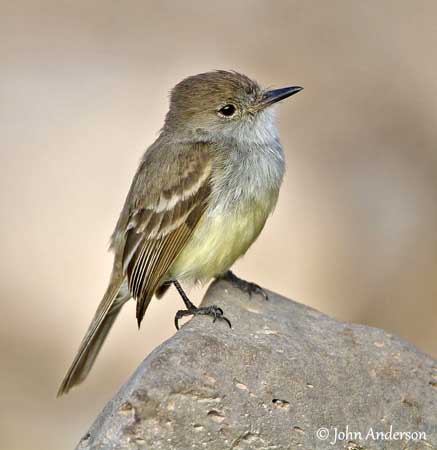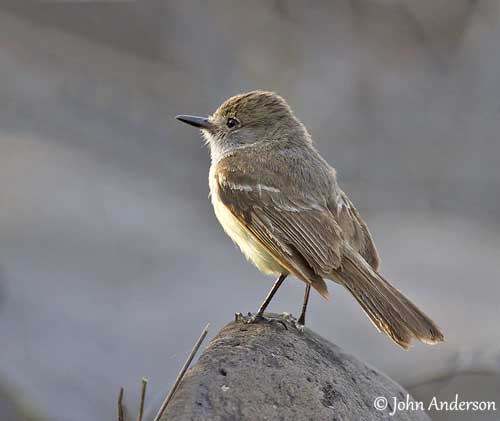
Fr: Tyran des Galápagos
All: Galapagosschopftyrann
Esp: Copetón de Galápagos
Ita: Pigliamosche delle Galapagos
Nd: Galápagostiran
Sd: Galapagostopptyrann
Photographer:
John Anderson
John Anderson Photo Galleries
Text by Nicole Bouglouan
Sources:
HANDBOOK OF THE BIRDS OF THE WORLD Vol 9 - by Josep del Hoyo - Andrew Elliot - David Christie - Lynx Edicions - ISBN: 8487334695
BirdLife International (BirdLife International)
Neotropical Birds – Cornell Lab of Ornithology
Galapagos Flycatcher
Myiarchus magnirostris
Passeriformes Order – Tyrannidae Family
INTRODUCTION:
The Galapagos Flycatcher is a monotypic species endemic to the Galapagos Islands. Formerly placed in the genus Eribates from a supposed “very long tarsus”, it is now included in the genus Myiarchus of which it is the smallest member. Like numerous island birds, it has become more terrestrial. Very tame and friendly, it is quite curious and shows little fear of humans.
DESCRIPTION OF THE BIRD:
Biometrics:
Length: 15-16 cm
The adult has olive-green upperparts. The wings are brown with rufous or greyish-white fringing, sometimes absent or indistinct. Greater and median wing-coverts are tipped greyish-white. The tail is brown too, with pale buff-edged rectrices.
On the underparts, chin, throat and breast are grey. Belly and undertail-coverts are pale yellow. Underwing-coverts are yellow.
The head is olive-green with faint rufous wash on the crown.
The bill is blackish. The eyes are dark brown. Legs and feet are blackish.
Both sexes are similar.
The juvenile shows rufous-tipped wing-coverts.

RANGE:
The Galapagos Flycatcher is present on all main Galapagos Islands.
HABITAT:
The Galapagos Flycatcher frequents all types of habitats except those without vegetation. It is fairly common at low elevation in shrubby areas with tall Opuntia cacti and less common in the most arid areas.
This species is visible from sea-level, on rocks at high-tide line, up to 900-1000 metres of elevation in grassy areas at mountaintops.
CALLS AND SONGS: SOUNDS BY XENO-CANTO
The Galapagos Flycatcher’s dawn song is a repeated complex phrase with “whay-burg” as introduction, followed by series of rapid “huit”. This song is one of the first sounds heard at dawn.
Other sounds such as a liquid “wheet-we” or “wheet-wheet-we” and a single, sharp “huit” are typical sounds of numerous Myiarchus species.
BEHAVIOUR IN THE WILD:
The Galapagos Flycatcher feeds primarily on arthropods, caterpillars and flying insects. It also consumes the fruits of Tournefortia rufosericea.
It performs hover-gleaning and often perches in the vegetation, usually 1-3 metres above the ground, from which it sallies to the ground for prey. It also searches for invertebrates in the overhanging vegetation, settled on the ground and looking upwards.
The Galapagos Flycatcher usually moves slowly among the vegetation, performing short flights from perch to perch while searching for preys.
Like other Myiarchus species, the Galapagos Flycatcher is territorial. Neighbour pairs may become aggressive when the nest-sites are too close from each other.
They are cavity-nesters and these cavities are used for roosting too, even outside the breeding season. Usually, they have the peculiar habit of adding some reptile skin or animal hair or feathers to the lining inside the cavity.
The Galapagos Flycatcher cannot use abandoned holes because woodpeckers are absent from the islands. But it uses a variety of enclosed sites, natural holes or abandoned domed nests of Darwin’s Finches.
This species is sedentary in its range. It does not perform long-sustained flights, but only short, quick bursts from ground or perch.

REPRODUCTION OF THIS SPECIES:
The breeding season occurs between December and March, during the hot wet season.
The Galapagos Flycatcher nests in cavities such as holes in trees or cacti, old nests of finches, and also uses electricity poles. The nests are usually more than 100 metres apart from each other.
In the cavity, the nest is lined with soft materials such as small twigs, fur, animal hair and chicken feathers.
The nest is often 1,5 to 3 metres above the ground, sometimes higher in trees.
The female lays 3-5 brown eggs with buff markings. The chicks fledge about 13 days after hatching.
PROTECTION / THREATS / STATUS:
The Galapagos Flycatcher is threatened by degradation of its habitat due to fires and overgrazing, predation by introduced mammals and diseases.
But currently, the species is still evaluated as Least Concern.